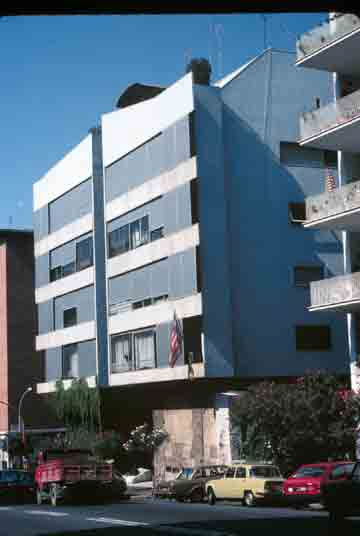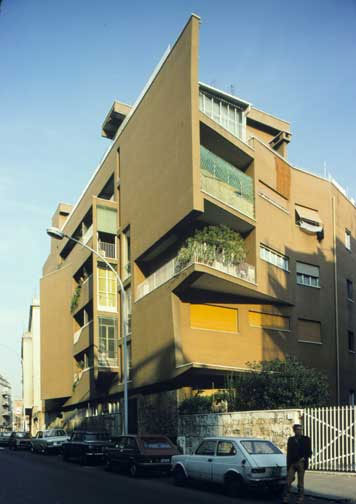| LUIGI MORETTI: Architect of the Watergate Complex Below are photographs of some other Moretti's architectural projects. A brief biography of Moretti is presented at the end of this page. But, first his work. |
||
| One sees predecessors of the Watergate Complex in the photos below. We see the palazzino-style and Watergate's "organic" curving, irregular shapes abutting planer and regular architectural forms to name just two similarities. | ||
| ASTREA The Astrea exemplifies a type of apartment building that was being designed by young Roman architects in the years immediately following World War II. These palazzine were free-standing "urban villas"designed for multi-family occupancy.
Like their palazzo predecessors a façade fronted the street with a zone of service-related spaces. Astrea and other projects combine modernist attitudes with traditional styles. Il Girasole (photographs below) is another palazzino-style dwelling. Moretti juxtaposed curved and planar surfaces in his later work, a theme that can be seen in the mixed-use development "Corso" (photographs below) in Milan in 1956 And it is as well a dominant theme in the Watergate Complex. Astrea was likely the predecessor of these works, -- a highly cerebral designs. 10 - 2 bedroom.flats, 6 floors w/courtyard. Materials are stucco, stone, wood windows, wooden roll-down and sliding shutters-built 1949-1950 |
|
|
| Il Girasole Rome -- During the 1950's, Moretti wrote a series of articles about structure, space and form where he examined the structure and mathematics of architecture. He was interested in "organic" building forms and ideas as seen in curving, irregular shapes abutting planer, regular architectural forms. This theme is clearly seen in his apartment buildings designs built between '49 and '62 in Rome: Astrea and Il Girasole, and elsewhere. Il Girasole, "the sunflower," may be Moretti's tour de force. The name is probably derived from the petal-like extensions which open--sunflower-like--to one side of the building. There are two large apartments per floor, spread outward from an interior courtyard. The street facade is remarkable as an abstract surface turned, like a sunflower, to face the south sun. The large linear apartments are arranged around an interior light well. There are ten three bedroom flats distributed over six floors, portiere quarters at entry courtyard. Il Girasole was built between 1949 and 1950. |
 |
|
| Corso Italia, Milan -- After WWII, Moretti practiced in Milan. Corso is an office, residential and shopping center constructed from 1951 to 1956 on one of the principle radial streets in the center of Milan. The structures were wedged into a space confined by the adjoining buildings on this irregularly shaped street.There are 40 two and three bedroom flats with shops, offices and below grade parking. The number of floors vary from 3 to 14 depending on the part of the building. The slightly deflected walls are similar to the Astrea Co-op of 1949. The narrow cleavage of the towers provides access to an internal garden similar to the Il Girasole in Rome in 1950. . |
 |
|
| Luigi Moretti was a complex and intense individual with a deep appreciation of art, national spirit and history. Throughout his career, Moretti sought guidance from his architectural forefathers in order to solve his design problems. Moretti was born in Rome, Italy in 1907, the son of a Belgian architect. He began his professional studies at the Advanced School of Architecture. But, he soon left the university to enter into building and urban planning competitions. He was awarded the projects and designed flats in Naples, Verona and Perugia |
From 1950 to 1953 Moretti published an architectural journal, Space where he explained his ideas concerning artistic expression as well as his theoretical reflections on architecture.
He was professionally active from 1932 to 1973. While he began his profession in Italy. he soon expanded to the United States, Canada, Algeria, Kuwait, and elsewhere. In 1973, he died from a heart attack. |
